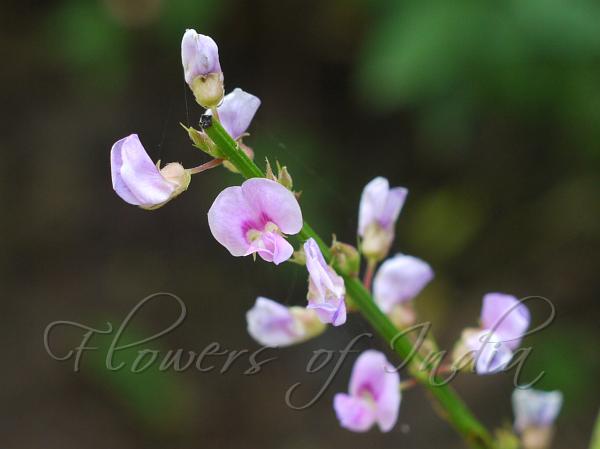|
| Winged-Stalk Desmodium |
|

|

| File size | 1500794 |
| Original date | 10/25/09 12:55 PM |
| Resolution | 2048 x 1536 |
| Flash | Flash did not fire, auto |
| Focal length | 45.0mm |
| Exposure time | 1/60s |
| Aperture | 5.6 |
| Focus Distance | |
| Metering Mode | Multi-segment |
| Camera make | Panasonic |
| Camera model | DMC-G1 |
| Sensor type | OneChipColorArea |
|
|
|
|
Photo: |
Botanical name: Tadehagi triquetrum Family: Fabaceae (Pea family)
Synonyms: Desmodium triquetrum, Hedysarum triquetrum, Pteroloma triquetrum
Synonyms: Desmodium triquetrum, Hedysarum triquetrum, Pteroloma triquetrum
Winged-Stalk Desmodium is a subshrub, growing up to
1-2 m tall, with erect stems which are almost woody. Branches are
triangular in cross section, velvety. Leaves are alternately arranged,
and the leaf stalk has prominent wings. Leaves are linear-oblong, ovate
or heart-shaped, with a tapering tip. Flowers arise in many-flowered
racemes in leaf axils. Flowers are small, shaped like pea flowers, pink
to pale violet, with a nearly circular standard petal, notched at tip;
wings obovate, eared, clawed; keel arcuate, eared, clawed. Legumes are
hairy, 5-8 jointed. Winged-Stalk Desmodium is found in the Himalayas
below 1400 m, China, SE Asia, South India and Sri Lanka. Flowering:
June-October.
Medicinal uses: Winged-Stalk Desmodium is used
to expel worms, treats spasms in infants, indigestion, piles and
abscesses; for invigorating the spleen and promoting digestion; for
hemorrhoids; for stomach discomfort; as a poultice on bruises and drunk
daily for chronic coughs and tuberculosis (decoction of roots); to
treat kidney complaints (infusion of roots); eaten or used in baths for
gastro-intestinal and urinary problems ranging from an upset stomach to
hepatitis (infusion or decoction of roots).
Winged-Stalk Desmodium is used
to expel worms, treats spasms in infants, indigestion, piles and
abscesses; for invigorating the spleen and promoting digestion; for
hemorrhoids; for stomach discomfort; as a poultice on bruises and drunk
daily for chronic coughs and tuberculosis (decoction of roots); to
treat kidney complaints (infusion of roots); eaten or used in baths for
gastro-intestinal and urinary problems ranging from an upset stomach to
hepatitis (infusion or decoction of roots).
Medicinal uses:
 Winged-Stalk Desmodium is used
to expel worms, treats spasms in infants, indigestion, piles and
abscesses; for invigorating the spleen and promoting digestion; for
hemorrhoids; for stomach discomfort; as a poultice on bruises and drunk
daily for chronic coughs and tuberculosis (decoction of roots); to
treat kidney complaints (infusion of roots); eaten or used in baths for
gastro-intestinal and urinary problems ranging from an upset stomach to
hepatitis (infusion or decoction of roots).
Winged-Stalk Desmodium is used
to expel worms, treats spasms in infants, indigestion, piles and
abscesses; for invigorating the spleen and promoting digestion; for
hemorrhoids; for stomach discomfort; as a poultice on bruises and drunk
daily for chronic coughs and tuberculosis (decoction of roots); to
treat kidney complaints (infusion of roots); eaten or used in baths for
gastro-intestinal and urinary problems ranging from an upset stomach to
hepatitis (infusion or decoction of roots). | Identification credit: Prashant Awale | Photographed in Maharashtra and Mizoram. |
• Is this flower misidentified? If yes,